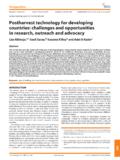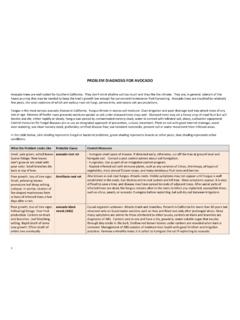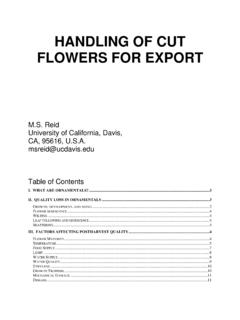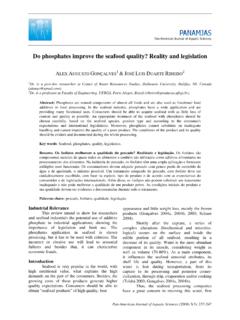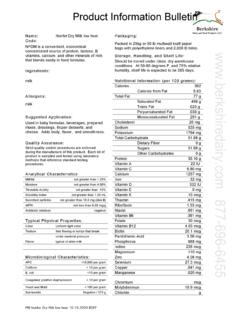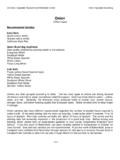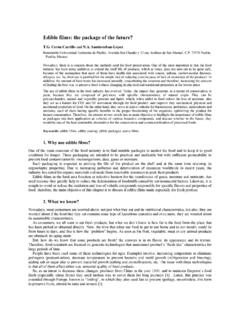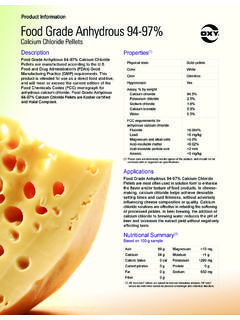Transcription of Postharvest Technology of Horticultural Crops - An ...
1 Ethiop .J. Appl. Sci. Technol. (Special Issue ): 1- 8 (2013) 1. OVERVIEW PAPER. Postharvest Technology of Horticultural Crops - An Overview from Farm to Fork Adel A. Kader Department of Plant Sciences, University of California Davis, CA 95616, USA. E-mail: ABSTRACT. Temperature management is the most effective tool for maintaining quality and safety and for extending the Postharvest - life of fresh Horticultural commodities. It begins with the rapid removal of field heat by initial cooling and continues throughout the cold chain (refrigerated transportation, cold storage at wholesale distribution centers, refrigerated retail display, and cold storage at home). Management of relative humidity along with temperature is essential in reducing water loss. The following technological procedures are used commercially as supplements to temperature and relative humidity management: Treatments applied to commodities include curing of certain root, bulb, and tuber vegetables; cleaning followed by removal of excess surface moisture; sorting to eliminate defects; waxing and other surface coatings, including film wrapping; heat treatments (hot water or air, vapor heat); treatment with special chemical treatments (sprout inhibitors, scald inhibitors, calcium, growth regulators, ethylene-action inhibitors, such as 1- methylcyclopropene, Postharvest fungicides); fumigation or irradiation for insect control; and ethylene treatment (de-greening citrus, ripening climacteric fruits).
2 Treatments to manipulate the environment include packaging, control of air movement and circulation, control of air exchange or ventilation, exclusion or removal of ethylene, controlled or modified atmospheres, and effective water disinfection and other sanitation procedures to minimize microbial contamination and assure food safety. Strategies for increasing food security by reducing Postharvest losses and waste include use of cultivars with longer Postharvest life, use of an integrated crop management system that maximizes yield and quality, and use of proper harvesting and Postharvest handling procedures to maintain quality and safety of Horticultural Crops and their products.. Keywords: fresh produce, fruits, Postharvest losses, quality, safety, vegetables 2 Adel A Kader INTRODUCTION Management of temperature and relative humidity Fresh Horticultural Crops are diverse in morphological structure (roots, stems, Temperature leaves, flowers, fruits, and so on), Temperature is the most important composition, and general physiology.
3 Environmental factor that influences the Thus, commodity requirements and deterioration of harvested commodities. recommendations for maximum Most perishable Horticultural Postharvest life vary among the commodities last longest at commodities. All fresh Horticultural temperatures near 0 C. At temperatures Crops are high in water content and are above the optimum, the rate of subject to desiccation (wilting, deterioration increases 2- to 3-fold for shriveling) and mechanical injury. They every 10 C rise in the temperature. are also susceptible to attack by bacteria Temperature influences how other and fungi, with pathological internal and external factors influence breakdown. Biological (internal) causes the commodity, and has a dramatic of deterioration include respiration rate, effect on the spore germination and ethylene production and action, rates of growth rate of pathogens. Temperatures compositional changes (associated with outside the optimal range can cause color, texture, flavor, and nutritive rapid deterioration due to the following value), mechanical injuries, water stress, disorders: sprouting and rooting, physiological disorders, and pathological breakdown.
4 Freezing - In general, perishable The rate of biological deterioration commodities are high in water content depends on several environmental (75 to 95%), and possess large, highly (external) factors, including vacuolated cells. The freezing point of temperature, relative humidity, air their tissues is relatively high (ranging velocity, and atmospheric composition from 3 C to C), and the disruption (concentrations of oxygen, carbon caused by freezing usually results in dioxide, and ethylene), and sanitation immediate collapse of the tissues and procedures. Fresh fruits and vegetables total loss of cellular integrity. play a very significant role in human nutrition, especially as sources of Chilling injury - Some commodities vitamins (Vitamin C, Vitamin A, (mainly those native to the tropics and Vitamin B6, thiamine, niacin), minerals, subtropics) respond unfavorably to and dietary fiber. Other constituents storage at low temperatures well above that may lower risk of cancer and other their freezing points, but below a critical diseases include flavonoids, carotenoids, temperature (between 5 and 13 C.)
5 Polyphenols and other phytonutrients. depending on commodity and maturity Postharvest losses in nutritional quality, stage) termed the chilling threshold particularly Vitamin C content, can be temperature or lowest safe temperature. substantial and are enhanced by Chilling injury is manifested in a variety physical damage, extended storage of symptoms including surface and duration, high temperatures, low internal discoloration, pitting, water relative humidity, and chilling injury of soaking, failure to ripen, uneven chilling-sensitive commodities. ripening, development of off flavors and heightened susceptibility to pathogen attack. Ethiop .J. Appl. Sci. Technol. (Special Issue ): 1- 8 (2013) 3. Heat injury - High temperatures are in relation to the produce load in the also very injurious to perishable cold storage room; (3) maintaining products. In growing plants, temperature of the refrigeration coils transpiration is vital to maintaining within about 1 C of the air temperature.
6 Optimal growth temperatures. Organs (4) providing moisture barriers that removed from the plant, however, lack insulate walls of storage rooms and the protective effects of transpiration, transit vehicles; (5) adding polyethylene and direct sources of heat, for example liners in containers and using perforated full sunlight, can rapidly heat tissues to polymeric films for packaging; (6). above the thermal death point of their wetting floors in storage rooms; (7). cells, leading to localized bleaching or adding crushed ice in shipping necrosis (sunburn or sunscald) or containers or in retail displays for general collapse. commodities that are not injured by the practice; and (8) sprinkling produce Relative Humidity with sanitized, clean water during retail Relative humidity (RH) is the moisture marketing of commodities that benefit content (as water vapor) of the from misting, such as leafy vegetables, atmosphere, expressed as a percentage cool-season root vegetables, and of the amount of moisture that can be immature fruit vegetables (such as snap retained by the atmosphere (moisture beans, peas, sweet corn, and summer holding capacity) at a given temperature squash).
7 And pressure without condensation. The moisture holding capacity of air Supplemental commodity treatments increases with temperature. Water loss Treatments applied to commodities is directly proportional to the vapor include: pressure difference (VPD) between the commodity and its environment. VPD is 1. Curing of certain root, bulb, and inversely related to RH of the air tuber vegetables to encourage wound surrounding the commodity. healing and drying of outer tissues. This RH can influence water loss, is an essential step for reducing water decay development, incidence and loss and disease infection during severity of some physiological subsequent storage. disorders, and uniformity of fruit ripening. Condensation of moisture on 2. Cleaning followed by removal of the commodity (sweating) over long excess surface moisture to avoid periods of time is probably more creating a microenvironment that is important in enhancing decay than is favorable to growth of decay-causing the RH of ambient air.
8 An appropriate pathogens during subsequent storage RH range for storage of fruits is 85 to and distribution. 95% while that for most vegetables 3. Sorting to eliminate defects and varies from 90 to 98%. The optimal RH. separate by quality grade that add value range for dry onions and pumpkins is 70. to the products and improve their to 75%. Some root vegetables, such as marketability. Use of electronic sorting carrot, parsnip, and radish, can best be machines based on nondestructive held at 95 to 100% RH. measurement of fruit color, size, and RH can be controlled by one or severity of defects is increasing. more of the following procedures: (1). adding moisture (water mist or spray, 4. Waxing and other surface coatings, steam) to air by humidifiers; (2) including film wrapping are used to regulating air movement and ventilation 4 Adel A Kader reduce water loss and in some cases circulation to minimize the impact on modify the atmosphere (oxygen and water loss rate and attain more carbon dioxide concentrations) around uniformity of temperature and relative the commodity.
9 Humidity throughout the storage area. 5. Heat treatments (hot water or air, 3. Control of air exchange or ventilation vapor heat) may be used for decay to avoid build-up of carbon dioxide and control (such as anthracnose on mango ethylene concentrations and deletion of and crown rot on banana) and/or for oxygen levels in the storage atmosphere. insect control to meet quarantine requirements for some commodities, 4. Exclusion or removal of ethylene to such as mango and papaya. avoid build-up of ethylene concentration to levels that damage the 6. Treatment with Postharvest commodity. fungicides (in the wax or separately) at concentrations that assure that the 5. Controlled or modified atmospheres residue level is below the maximum (CA or MA) may be used to extend the residue limit (MRL) allowed by the Postharvest -life of some commodities, regulatory authorities. such as apple, avocado, cabbage, cherry, mango, pear, persimmon, pomegranate, 7. Special chemical treatments (sprout and tomato (mature-green and breaker inhibitors, scald inhibitors, calcium, stages).)
10 Growth regulators, ethylene action inhibitors, such as 1- 6. Effective water disinfection (with methylcyclopropene, and/or chlorine, chlorine dioxide, ozone, or Postharvest fungicides) other disinfectants) and other sanitation procedures (such as frequent cleaning of 8. Fumigation (with methyl bromide or equipment used with sanitizing agents). phosphine) or irradiation (at less than 1 to minimize microbial contamination kGY) for insect control to satisfy and assure food safety. quarantine requirements of the importing country. Produce compatibility during transport and storage 9. Ethylene treatment to de-greening Storage under conditions outside the citrus fruits (1-5 ppm ethylene in air), optimal window for each commodity is and for ripening climacteric fruits, such a common reason for Postharvest losses as avocado, banana, mango, and tomato in produce quality and quantity. The (100-150 ppm ethylene in air). following factors determine compatibility in mixing various fruits Supplemental treatments to and vegetables together during manipulate the environment transport and storage: Treatments to manipulate the 1.



